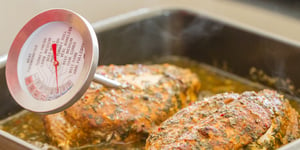 Want to lower your Restaurant Insurance costs? Minimize risk. It’s that simple. It may not always be easy, but it’s always that simple.
Want to lower your Restaurant Insurance costs? Minimize risk. It’s that simple. It may not always be easy, but it’s always that simple.
One way to minimize risk is to take every precaution to ensure the safety of the food you’re serving. One mistake can result in a customer becoming ill, the destruction of your reputation, a health department inspection, a lawsuit, or even shutting your restaurant down, and of course, higher insurance premiums.
According to the CDC, every year, approximately 48 million people get sick, and 3,000 die from foodborne diseases. The majority of foodborne illnesses are caused by foodborne pathogens, such as bacteria, viruses, and parasites, and most of those can be eliminated in a restaurant kitchen with strictly enforced food safety protocols.
According to the Health Care Agency, the top five causes of foodborne illnesses are as follows:
- Dirty and/or contaminated utensils and equipment
- Poor employee health and hygiene
- Improper hot/cold holding temperatures of potentially hazardous food
- Improper cooking temperatures of food
- Food from unsafe sources
Here are three tips to minimize most of those risks.
Clean and Sanitize
Perhaps more than any other industry, cleanliness is crucial in the food industry where cross-contamination is always a concern. First, you need to make sure every surface in your kitchen is clean – from cutting boards to stovetops (which also helps avoid fires). Make sure every tool in your kitchen is regularly cleaned and sanitized – from dishes to cooking utensils. And don’t forget those hidden spaces like ovens and refrigerators.
Regularly wipe down surfaces, and make sure that whatever you are using – a sponge, rag, etc. – is actually cleaning the surface and not just moving the dirt around, creating a breeding ground for germs and bacteria. Regularly replace disposable items and wash rags daily.
Every food contact surface, utensil, food prep equipment should be washed, rinsed, and sanitized at least once every four hours. Ovens, stoves, grills, and hoods should be thoroughly cleaned every night.
And don’t forget about the role your employees play in keeping your restaurant clean. Train them about the importance of cleanliness and how to maintain a clean restaurant and remind them frequently with posters, signs, and on-going training. Advise them not to come to work when they are sick, and make sure they wash their hands regularly.
The CDC recommends employees wash their hands during these critical times:
- Before, during, and after preparing any food.
- After handling raw meat, poultry, seafood, and eggs.
- Before eating.
- After touching garbage.
- After wiping counters or cleaning other surfaces with chemicals.
- After touching pets, pet food, or pet treats.
- After coughing, sneezing, or blowing your nose.
To properly wash your hands, the CDC recommends following these five steps to prevent the spread of germs:
- Wet your hands with clean, running water (warm or cold), turn off the tap, and apply soap.
- Lather your hands by rubbing them together with the soap. Lather the backs of your hands, between your fingers, and under your nails.
- Scrub your hands for at least 20 seconds. Need a timer? Hum the “Happy Birthday” song from beginning to end twice.
- Rinse your hands well under clean, running water.
- Dry your hands using a clean towel or air dry them.
Pay Attention to Temperatures
When cooking, remember that some meats, like beef or lamb, can be served rare or, in some cases, raw; whereas, pork and chicken must be cooked thoroughly. Use a food thermometer to ensure that food (especially meats) are cooked to safe minimum internal temperatures.
Also, remember to keep food out of the “danger zone” (40°F - 140°F) where bacteria can grow most rapidly. Keep hot food at 140°F or higher and cold food at 40°F or lower. Don’t leave food out of the refrigerator for more than two hours or one hour if the temperature is above 90°F.
Bacteria can be reintroduced to food after it is safely cooked, so put leftovers in shallow containers for quick cooling and then refrigerate them at 40°F or lower within two hours.
Avoid Cross-Contamination
Cross-contamination is the transfer of harmful bacteria or other microorganisms from one person, object, or place to another. Preventing cross-contamination is key to preventing foodborne illness. Keeping everything clean is your first step, but there are other things you can do.
The three main types of cross-contamination are food-to-food, equipment-to-food, and people-to-food. To avoid food-to-food cross-contamination, thoroughly wash all fruits and vegetables and keep raw and cooked food stored separately.
Avoid equipment-to-food contamination by making sure all equipment and surfaces are thoroughly washed and use different cutting boards, utensils, and containers for different types of food, such as raw meat and poultry products to avoid cross-contamination. Replace cutting boards when they develop hard-to-clean cuts.
People can also transfer bacteria through their bodies or clothes while preparing or serving food. Remind employees to wash their hands frequently and to keep their hair pulled back or restrained in a hair net.
Protect Your Restaurant with The Right Insurance
Sometimes despite your best efforts, a customer will become ill. The experienced agents at American Insuring Group can make sure you have the right insurance coverage to protect your restaurant against potential lawsuits and, as independent agents, compare pricing among many competing carriers to ensure you get the lowest price for that great coverage.
Give us a call today at (800) 947-1270 or (610) 775-3848 or connect with us online.







